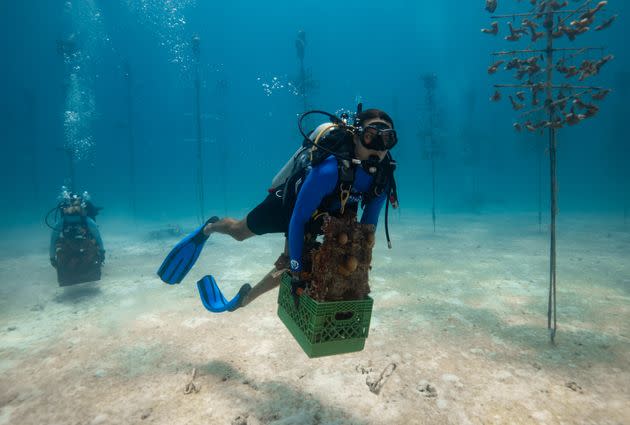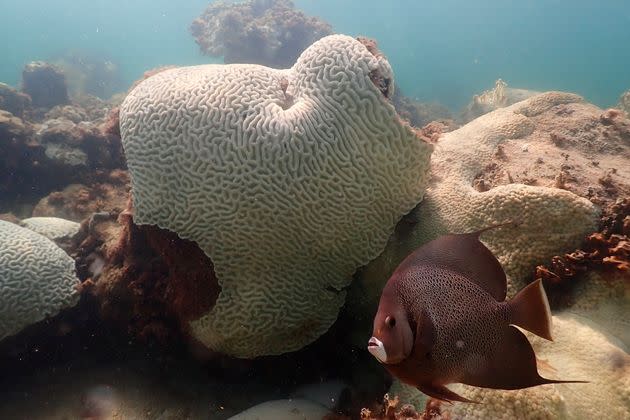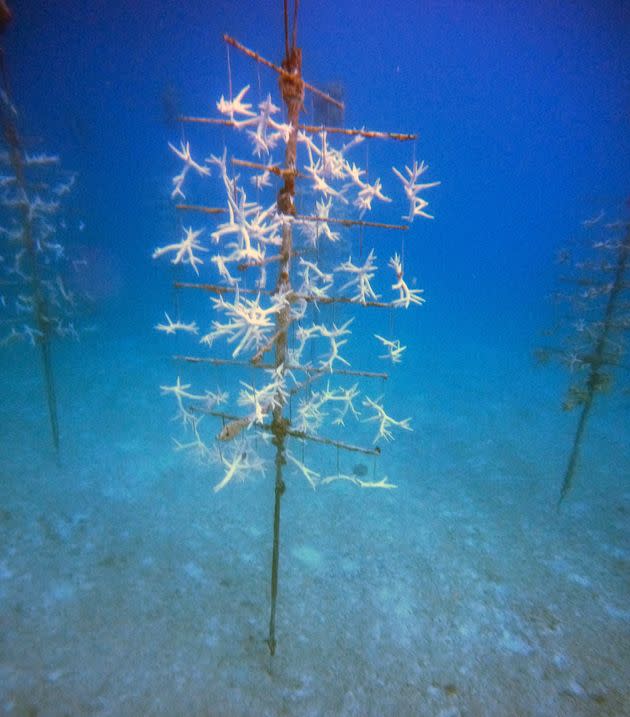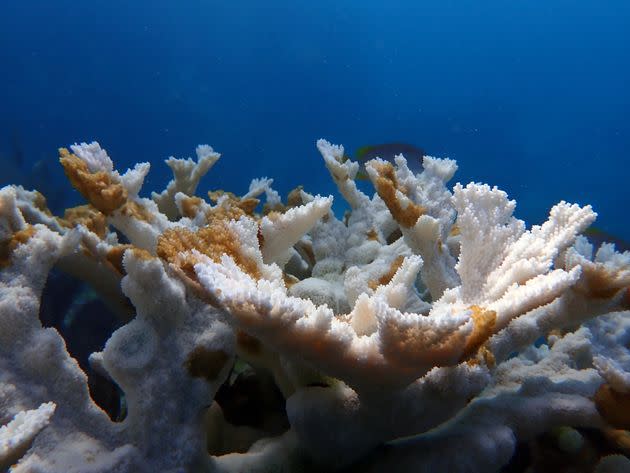In The Florida Keys, Scientists Race To Rescue Corals From Deadly Ocean Temperatures
In April, the Coral Restoration Foundation, a Florida-based reef restoration nonprofit, unveiled its new “coral bus,” which it described as “a cutting-edge aquarium trailer system designed to transport nursery-raised corals safely to their new homes within the Florida Keys National Marine Sanctuary.”
But just three months after the bus first hit the road, it is being used as part of a much more desperate and sobering effort ― not to haul corals out to sea, but to evacuate hundreds of them from the record-shattering and relentless marine heat wave now ravaging reefs in the Florida Keys, and to prepare the ecosystem for what’s coming soon.
“In order to restore coral reefs, we need to maintain genetic diversity of the local populations,” Phanor Montoya-Maya, the foundation’s restoration program manager, told HuffPost. “We’re going to try to save as much as we can, so we have a good representation of that genetic diversity that will help coral reefs to bounce back.”
As of Monday, more than 1,500 corals had been relocated from offshore nurseries to climate-controlled water tanks at the Keys Marine Laboratory in Layton, Florida. They are expected to remain there for several months, until ocean temperatures subside, after which they will be returned to offshore nurseries. The rescue effort, coordinated by the National Oceanic and Atmospheric Administration, involves numerous organizations that have been on the front lines of trying to restore degraded reefs off Florida’s coast.
Since early July, surface water temperatures in the Keys have hovered in the mid-90s, way above the mid-July average. On Monday, a buoy in Manatee Bay, off the coast of Key Largo, recorded water temperatures reaching a stunning 101.1 degrees — a normal temperature for a hot tub and, if verified, potentially the hottest sea surface temperature ever recorded.

Divers with the Coral Restoration Foundation evacuate corals from its Tavernier Coral Tree Nursery, in the Florida Keys, on July 23. An extreme marine heat wave is devastating coral reefs throughout South Florida.
When corals are exposed to prolonged spells of hot water, they typically become stressed and expel their zooxanthellae ― the symbiotic algae that they rely on for most of their food ― and turn white, a phenomenon known as “coral bleaching.” If temperatures return to normal, bleached corals can recover. If not, they starve and perish.
But in areas of the Keys, scientists have watched as endangered elkhorn and staghorn corals died without ever showing signs of bleaching.
“The coral didn’t have time to release their zooxanthellae. They pretty much... burned to death,” Montoya-Maya said.
Other corals along Florida’s southern coast have shown familiar signs of heat-related stress, turning ghost white after ocean temperatures soared earlier this month. The Keys and much of the Caribbean are now under NOAA’s highest alert level for bleaching, which means reefs there have a 90% chance of severe bleaching and mortality over the next several months.
The carnage in the Keys is part of a crisis facing fragile reefs around the globe, as climate change fuels marine heat waves, mass bleaching events and disease outbreaks. In 2018, the United Nations’ Intergovernmental Panel on Climate Change issued a dire warning about the future of the world’s reefs, forecasting that at just 1.5 degrees Celsius of warming above pre-industrial levels — a mark that the planet is now forecast to surpass as soon as 2027 — between 70% and 90% of all reefs could perish. At 2 degrees of warming, an unfathomable 99% of reefs could be lost.
Corals provide habitat for more than 25% of the planet’s marine species, and generate goods and services valued at $375 billion each year. They are the backbone of many tourism-based economies, including in the Florida Keys.

A fish swims near coral showing signs of bleaching at Cheeca Rocks off the coast of Islamorada, Florida, on July 23.
Warm water and coral bleaching are nothing new in South Florida. In fact, reefs in the Keys are already a skeleton of what they once were, with upward of 90% of coral cover having vanished since the 1970s due to warming temperatures, disease and other threats.
Peak bleaching usually doesn’t occur until late summer. But this year’s onslaught came early and fast. And it threatens to wipe out much of the coral that remains, including nurseries where scientists are growing corals as part of a broad effort to restore degraded reefs throughout the Keys.
In a recent Q&A posted to NOAA’s website, Derek Manzello, coordinator of NOAA’s Coral Reef Watch, talked about the unprecedented nature of the current marine heat wave.
“We are a full month ahead of what we, historically, have called the normal ‘bleaching season,’” he said. “What this means is, unless significant cooling takes place (for example, repeat passage of hurricanes, or tropical storms), the corals of the Florida Keys may be looking at upwards of three consecutive months of thermally-stressful conditions. This would be unprecedented in the satellite record, because most previous bleaching events lasted about four to six weeks.”
On July 6, Keri O’Neil, director and senior scientist at the Florida Aquarium’s Coral Conservation Program, visited a site on Tennessee Reef, near Layton, where a few years earlier the aquarium planted hundreds of baby corals that had been spawned and raised in a lab. Everything looked healthy, but the water temperature had already risen to 91 degrees. O’Neil and a team returned to check on the corals again two weeks later, and found almost total devastation.
“What was healthy on July 6 was near-complete mortality on July 19,” she said. “We had hoped that, being that each one of those 200 corals at the site was a unique individual, that at least a few of them might be resilient. Each one has a unique genetic makeup. But it just wiped out all of them.”
The Coral Restoration Foundation has documented similar die-offs. Earlier this month, at a restoration site at Sombrero Reef where CRF has been working for over a decade, it reported “100% coral mortality.” The organization also lost nearly every coral at its nursery at Looe Key.
“This is very rare in terms of the onset, how quickly that it happened,” Montoya-Maya said of the bleaching, which scientists fear could end up being the worst event on record in Florida. “The problem is that it happened too quickly, too soon, too fast.”

Bleached corals are seen at a coral nursery at Florida's Looe Key on July 21.
The neighboring Bahamas is also preparing for a calamitous year of bleaching.
“It’s coming,”said Sam Teicher, the founder of Coral Vita, a Bahamas-based private company that is farming corals in an effort to restore and maintain reefs against myriad mounting threats. “We have the same coral species here, [just] separated by the channel between us and Florida and further north.”
His team surveyed several reefs this week off Grand Bahama and found evidence of varying degrees of heat-related stress, from widespread paling of fire corals to full bleaching of star and brain corals. In an effort to temporarily safeguard corals at its underwater nurseries, it has moved them into deeper, cooler waters. In the coming days, Coral Vita plans to start relocating nursery corals to its coral farm on land in Freeport.
Montoya-Maya and O’Neil said the past two weeks have been devastating for Florida’s coral restoration community. Some scientists have wept in the field after seeing years of their work get destroyed in just a matter of days, a spokesperson for CRF told HuffPost.
“We talk about trying to make resilient corals and resilient reefs,” O’Neil said. “And right now, we need resilient humans to keep trying to make a difference and save things, because it’s so mentally draining for all of us now.”
For coral scientists, mass bleaching events are like watching all the trees in the Amazon rainforest be cut down, O’Neil said.
“It’s just so difficult to think about the future right now, because every day we’re being faced with more and more doom and gloom,” she said. “It honestly makes you start to question everything.”
Still, they remain committed to the mission — to restarting reef restoration efforts, if necessary, when the heat finally does let up.
“Nobody wants to give up,” O’Neil said. “We’re going to have to learn something from this summer.”

A bleached and dying coral at Sombrero Reef, south of Marathon, Florida.
Back in 2016, scientists hoped that the rapid demise of corals could be the thing that would convince the world to take aggressive action on climate change, as HuffPost reported at the time. But in the years since, the world has largely failed to rein in planet-warming greenhouse gas emissions.
Still, scientists and coral advocates are once again hopeful that this event will be the wake-up call.
“We need climate action now. That’s what we need. We need to stop just talking and talking,” Montoya-Maya said. “We can definitely recover populations of our corals in the Florida Keys and anywhere in the world, but if we don’t take climate action, all the [efforts] that we have done are going to be for nothing.”
Teicher said it is “infuriating” to see what’s happening in the region right now.
“I still have hope,” he said. “But as someone who is working to rapidly scale restoration, the best thing — full stop — to do to protect them is to stop killing them. And that’s on anyone and everyone that holds power or influence in politics, industry, finance and the media.”
